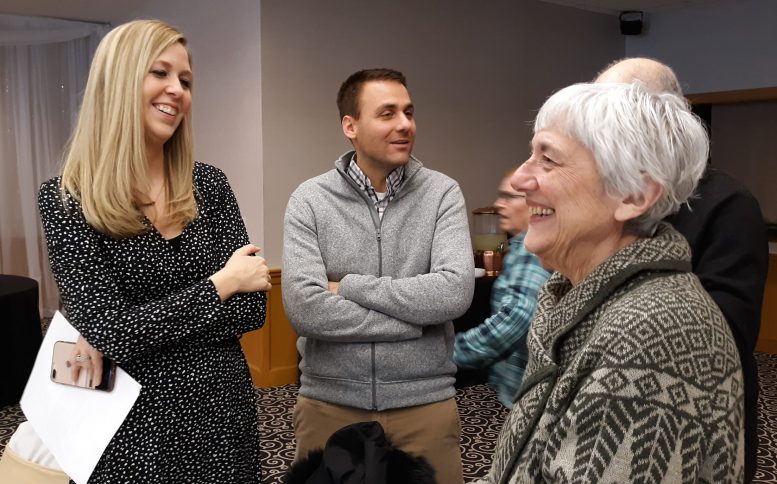By JAN LARSON McLAUGHLIN
BG Independent News
As the reading teacher at Crim Elementary School, Erica Blust faces a daunting challenge. Only 35% of the children starting school there come in prepared for kindergarten.
But Blust is not discouraged by the odds. She has, afterall, been teaching since age 5.
As the Bowling Green Kiwanis Club’s inspirational elementary teacher of the year, Blust talked about teaching to the group on Thursday. It was one of the rare snow days of this winter, but she showed up ready to share.
Blust showed old photographs of the first class she taught. Her “students” were much older than she at age 5.
“It really began as a child,” she said. “I would line up my family members and teach.”
She recalled a favorite teacher, who used hands-on lessons to make learning fun. And she remembered tutoring elementary children when she was in high school.
Blust started out at Ridge Elementary for four years, then moved to Crim Elementary for the last eight years. She has worked as a classroom teacher, and now specializes in helping struggling readers in kindergarten and first grade.
“I just believe reading levels the playing field for students,” she said.
That is a challenge – with nearly two-thirds of kindergartners arriving at Crim unprepared with the basic skills expected in the state. The biggest obstacle is poverty, said Crim Principal Zeb Kellough.
So Blust focuses her attention on kindergartners and first graders.
“We know early intervention is where we’re really going to help our students,” she said.
Bit by bit, many of those students make up ground, Kellough said.
“We do see growth,” he said. But while the number of reading students may grow from 35% to 60%, the third grade reading threshold for the state is 80%, he said.
Blust said the third grade reading standards set by the state have pros and cons.
“We’re being held accountable,” she said. “But there’s more to it than the scores coming out.”
There are children who suffer from test anxiety, and children who come to school hungry or struggling with issues at home. They are judged by their performance on one test on one particular day.
But Blust battles on patiently with struggling readers, convincing them they are not failures.
“It’s like riding a bike,” Kellough said. “Everyone learns at a different time and a different rate.”
Through continuing education, Blust has learned the value of using a multi-sensory approach to reading. She gave the Kiwanis members a sample of that method, letting them trace letters in sparkly sand, and write letters with crayons on bumpy screens.
Blust shared a book, “Thank you Mr. Falker,” about a little girl who struggled with reading. While her classmates saw alphabetic letters on the page, she just saw wriggly shapes. But one day, working with a creative teacher, reading began to click for the student.
That little girl became author Patricia Polacco, who wrote that book and many others for young readers.
Blust finds inspiration from her students, continuing education, and her colleagues.
“These teachers go above and beyond for their students,” she said of her co-workers at Crim. “I’m beyond proud to work beside them.”
Later in the month, the Kiwanis will recognize the inspirational teachers of the year at the middle school and high school.

